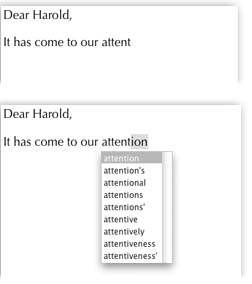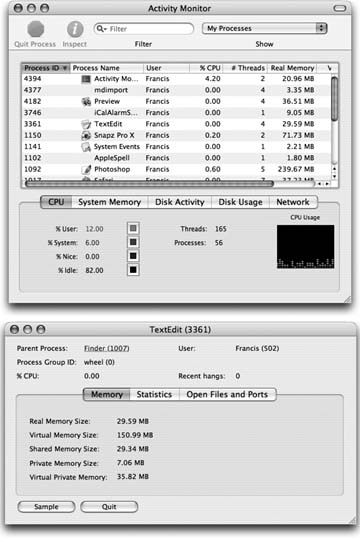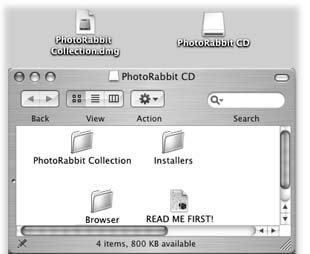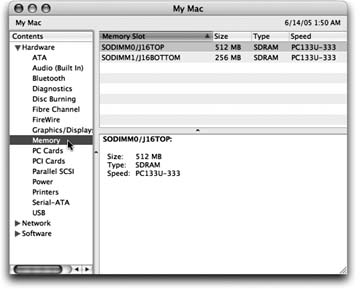Chapter 11. CDs, DVDs, and iTunes
| < Day Day Up > |
10.26. Utilities: Your Mac OS X ToolboxThe Utilities folder (inside your Applications folder) is home to another batch of freebies: another couple of dozen tools for monitoring, tuning, tweaking, and trouble-shooting your Mac. The truth is that you're likely to use only about six of these utilities. The rest are very specialized gizmos primarily of interest to network administrators or Unix geeks who are obsessed with knowing what kind of computer-code gibberish is going on behind the scenes. Tip: Even so, Apple obviously noticed that as the sophistication of Mac OS X fans grows, more people open the Utilities folder more often. That's why Tiger features a menu command and a keystroke that can take you there. In the Finder, choose Go  Utilities (Shift- -U). Utilities (Shift- -U). 10.26.1. Activity MonitorActivity Monitor is designed to let the technologically savvy Mac fan see how much of the Mac's available power is being tapped at any given moment. 10.26.1.1. The Processes tableEven when you're only running a program or two on your Mac, dozens of computational tasks ( processes ) are going on in the background. The top half of the dialog box, which looks like a table, shows you all the different processesvisible and invisiblethat your Mac is handling at the moment.
Check out how many items appear in the Process Listing Window, even when you're just staring at the desktop. It's awesome to see just how busy your Mac is! Some are easily recognizable programs (such as Finder), while others are background system-level operations you don't normally see. For each item, you can see the percentage of CPU being used, who's using it (either your account name , someone else's, or root , meaning the Mac itself), and how much memory it's using. 10.26.1.2. The System monitor tabsAt the bottom of Activity Monitor, you're offered five tabs that reveal intimate details about your Mac and its behind-the-scenes efforts (Figure 10-39):
10.26.2. AirPort Admin UtilityYou don't use the AirPort Admin Utility to set up AirPort connectionsthat is, wireless networks like those described in Chapter 13 initially. For that task, use the AirPort Setup Assistant (described below).
After you're set up, you can use AirPort Admin Utility to monitor the connections in an existing AirPort network. You can also use this utility to set up new connections manually, rather than using the step-by-step approach offered by the Assistant. 10.26.3. AirPort Setup Assistant(s)An Assistant, in Apple-ese, is an interview program. It presents a series of screens, posing one question at a time. At the end of the interview, the Assistant program incorporates your answers into a finished product. For example, it configures numerous System Preferences all at once. The AirPort Setup Assistant walks you through setting up and using AirPort wireless networking. You're asked to name your network, provide a password for accessing it, and so on. Once you've followed the steps and answered the questions, your AirPort hardware will be properly configured and ready to use. Note: Weirdly enough, Tiger gives you two AirPort Setup Assistant programs. AirPort Setup Assistant sets up AirPort Express or AirPort Extreme base stations , while AirPort Setup Assistant for Graphite and Snow works with the old, non-Extreme base stations. 10.26.4. Audio MIDI SetupMaybe you've heard that Mac OS X comes with spectacular internal wiring for music, sound, and MIDI (Musical Instrument Digital Interface, a standard "language" for inter-synthesizer communication). It's available, that is, to music software companies that write their wares to capitalize on these new tools. (The big-name programs, including Digital Performer, are ready to go.) This configuration program offers two tabs. The first, Audio Devices, is the master control panel for all your various sound inputs and outputs: microphones, line inputs, external speakers, and so on. For most people, this is meaningless, because most Macs have only one input (the microphone) and one output (the speakers ). But if you're sitting in your darkened music studio, humming with high-tech audio gear whose software has been designed to work with this little program, you're smiling. The second tab, MIDI Devices, should look familiar to synthesizer fans who have used software like OMS or FreeMIDI to teach the Mac about their studio configurations. By clicking Add Device, you create a new icon that represents one of your pieces of gear. Double-click the icon to specify its make and model. Finally, by dragging lines from the "in" and "out" arrows, you teach your Mac and its MIDI software how the various components are wired together. 10.26.5. Bluetooth File ExchangeOne of the luxuries of using a Mac that has Bluetooth is the ability to shoot files (to colleagues who own similarly clever gadgets) through the air, up to 30 feet away. Bluetooth File Exchange makes it possible, as described on Section 7.2.5. 10.26.6. ColorSync UtilityIf you use ColorSync (because you're in the high-end color printing business, for instance), you might be surprised to find that the ColorSync pane is gone from the System Preferences program. Instead, that pane's settings have been merged into this beefed-up program. This bet-you'll-never-touch-it utility combines two functions:
10.26.7. ConsoleConsole is a viewer for all of Mac OS X's text logsthe behind-the-scenes, internal Unix status messages being passed between the Mac OS X and other applications. Opening the Console log is a bit like stepping into an operating room during a complex surgery: You're exposed to stuff the average person just isn't supposed to see. (Typical Console entries: "kCGErrorCannotComplete" or "doGetDisplay TransferByTable.") You can adjust the font and word wrapping using Console's Font menu, but the truth is that the phrase "CGXGetWindowType: Invalid window1" looks ugly in just about any font! Console isn't useless, however. These messages can be of significant value to programmers who are debugging software or troubleshooting a messy problem, or, occasionally, to someone you've called for tech support. 10.26.8. DigitalColor MeterDigitalColor Meter can grab the exact color value of any pixel on your screen, which can be helpful when matching colors in Web page construction or other design work. After launching the DigitalColor Meter, just point anywhere on your screen. A magnified view appears in the meter window, and the RGB (red-green-blue) color value of the pixels appears in the meter window. You can display the color values as RGB percentages or actual values, in Hex form (which is how colors are defined in HTML; white is represented as #FFFFFF, for example), and in several other formats. Here are some tips for using the DigitalColor Meter to capture color information from your screen:
10.26.9. Directory AccessIf you use your Mac at home, or if it's not connected to a network, you'll never have to touch Directory Access. Even if you are connected to a network, there's only a remote chance you'll ever have to open Directory Accessunless you happen to be a network administrator, that is. This utility controls the access that each individual Mac on a network has to Mac OS X's directory services special databases that store information about users and servers. Directory Access also governs access to LDAP directories (Internet- or intranet-based "white pages" for Internet addresses). A network administrator can use Directory Access to do things like select NetInfo domains, set up search policies, and define attribute mappings. If those terms don't mean anything to you, just pretend you never read this paragraph and get on with your life. 10.26.10. Disk UtilityThis important program serves two key functions:
The following discussion tackles the program's two personalities one at a time. 10.26.10.1. Disk Utility, the hard driverepair programHere are some of the tasks you can perform with this half of Disk Utility:
Note: Disk Utility can't verify, repair, erase, or partition your startup disk the disk on which your system software is currently running. That would be like a surgeon performing an appendectomy on himselfnot a great idea. (It can fix the permissions of the disk it's on, thank goodness.)If you want to use Disk Utility to fix or reformat your startup disk, you must start up your Mac from a different system disk, such as the Mac OS X Install disc. The left Disk Utility panel lists your hard drive and any other disks in or attached to your Mac at the moment. When you click the name of your hard drive's mechanism, like "74.5 GB Hitachi iC25N0" (not the "Macintosh HD" partition label below it), you see a panel with five tabs, one for each of the main Disk Utility functions:
Tip: Instead of clicking a disk icon and then clicking the appropriate Disk Utility tab, you can just Control-click a disk's name and choose Information, First Aid, Erase, Partition, RAID, or Restore from the shortcut menu. 10.26.10.2. Disk Utility, the disk-image programThe world's largest fan of disk image is Apple itself; the company often releases new software in disk-image form. A lot of Mac OS X add-on software arrives from your Web download in disk-image form, too, as shown below. Disk images are popular for software distribution for a simple reason: Each image file precisely duplicates the original master disk, complete with all the necessary files in all the right places. When a software company sends you a disk image, it ensures that you'll install the software from a disk that exactly matches the master disk. It's important to understand the difference between a disk-image file and the mounted disk (the one that appears when you double-click the disk image). Figure 10-41 makes the distinction clear. Tip: After you double-click a disk image, click Skip in the verification box that appears. If something truly got scrambled during the download, you'll know about it right awayyour file won't decompress correctly, or it'll display the wrong icon, for example.In fact, you can make Disk Utility always skip that verification business, which is a relic from the days of floppy disks. To do so, choose Disk Utility  Preferences, click the Mounting tab, and turn off Verify Checksums. Preferences, click the Mounting tab, and turn off Verify Checksums. | |||||||||||
|
-
You want to create a backup of an important CD. By turning it into a disk-image file on your hard drive, you'll always have a safety copy, ready to burn back onto a new CD. (This is an essential practice for educational CDs that kids will be handling soon after eating peanut butter and jelly .)
-
You want to replicate your entire hard drivecomplete with all of its files, programs, folder setups, and so ononto a new, bigger hard drive (or a new, better Mac), using the new Restore feature described earlier.
-
You want to back up your entire hard drive, or maybe just a certain chunk of it, onto an iPod or another disk. (Again, you can later use the Restore function to complete the transaction.)
-
You bought a game that requires its CD to be in the drive at all times. Many programs like these run equally well off of a mounted disk image that you made from the original CD.
-
You want to send somebody else a copy of a disk via the Internet. You simply create a disk image, and then send that preferably in compressed form.
Here's how you make a disk image.
-
To image-ize a disk or partition . Click the name of the disk you want in the left-panel list, where you see the disks currently in, or attached to, your Mac. (The topmost item is the name of your drive , like "484.0 MB MATSHITADVD-R" for a DVD drive or "74.5 GB Hitachi" for a hard drive. Beneath that entry, you generally see the name of the actual partition, like "Macintosh HD," or the CD's name as it appears on the screen.)
Then choose File
 New
New  Disk Image from [whatever the disk or partitions name is].
Disk Image from [whatever the disk or partitions name is]. -
To image-ize a folder . Choose File
 New
New  Disk Image from Folder. In the Open dialog box, click the folder you want and then click Image.
Disk Image from Folder. In the Open dialog box, click the folder you want and then click Image.
Either way, the next dialog box (Figure 10-42) offers some fascinating options.
-
Image Format . If you choose "read/write," your disk image file, when double-clicked, turns into a superb imitation of a hard drive. You can drag files and folders onto it, drag them off of it, change icons' names on it, and so on.
If you choose "read-only," however, the result behaves more like a CD. You can copy things off of it, but not make any changes to it.
The "compressed" option is best if you intend to send the resulting file by email, or if you'd like to preserve the disk image on some backup disk for a rainy day. It takes a little longer to create a simulated disk when you double-click the disk image file, but it takes up a lot less disk space than an uncompressed version.
Finally, choose "DVD/CD master" if you're copying a CD or a DVD. The resulting file is a perfect mirror of the original disc, ready for copying onto a blank CD or DVD when the time comes.
-
Encryption . Here's an easy way to lock private files away into a vault that nobody else can open. If you choose "AES-128 (recommended)," you're asked to assign a password to your new image file. Nobody can open it without the passwordnot even you. On the other hand, if you save it into your Keychain (Section 12.11.5), it's not such a disaster if you forget the password.
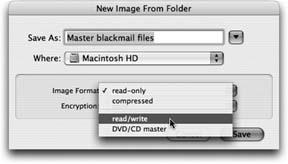
Figure 10-42. These two pop-up menus let you specify (a) what kind of disk image you want, and (b) whether or not you want it password- protected. The latter option is great when you want to password-protect one folder, without bothering with your entire Home folder.
-
Save As . Choose a name and location for your new image file. The name you choose here doesn't need to match the original disk or folder name.
When you click Save (or press Enter), if you opted to create an encrypted image, you're asked to make up a password at this point.
Otherwise, Disk Utility now creates the image and then mounts itthat is, turns the image file into a simulated, yet fully functional, disk icon on your desktop.
When you're finished working with the disk, eject it as you would any disk (Control-click it and choose Eject, for example). Hang onto the .dmg disk image file itself, however. This is the file you'll need to double-click if you ever want to recreate your "simulated disk."
10.26.10.3. Turning an image into a CD
One of the other most common disk-image tasks is turning a disk image back into a CD or DVDprovided you have a CD or DVD burner on your Mac, of course.
All you have to do is drag the .dmg file into the Disk Utility window, select it, and click the Burn icon on the toolbar (or, alternatively, Control-click the .dmg icon and choose Burn from the shortcut menu). Insert a blank CD or DVD, and then click Burn.
10.26.11. Grab
Grab takes pictures of your Mac's screen, for use when you're writing up instructions, illustrating a computer book, or collecting proof of some secret screen you found buried in a game. You can take pictures of the entire screen (press ![]() -Z, which for once in its life does not mean Undo) or capture only the contents of a rectangular selection (press Shift-
-Z, which for once in its life does not mean Undo) or capture only the contents of a rectangular selection (press Shift- ![]() -A). When you're finished, Grab displays your snapshot in a new window, which you can print, close without saving, or save as a TIFF file, ready for emailing or inserting into a manuscript.
-A). When you're finished, Grab displays your snapshot in a new window, which you can print, close without saving, or save as a TIFF file, ready for emailing or inserting into a manuscript.
Now, as experienced Mac enthusiasts already know, the Mac OS has long had its own built-in shortcuts for capturing screenshots: Press Shift- ![]() -3 to take a picture of the whole screen, and Shift-
-3 to take a picture of the whole screen, and Shift- ![]() -4 to capture a rectangular selection.
-4 to capture a rectangular selection.
So why use Grab instead? In many cases, you shouldn't. The Shift- ![]() -3 and Shift-
-3 and Shift- ![]() -4 shortcuts work like a dream. But there are some cases in which it might make more sense to opt for Grab. Here are three:
-4 shortcuts work like a dream. But there are some cases in which it might make more sense to opt for Grab. Here are three:
-
Grab can make a timed screen capture (choose Capture
 Timed Screen, or press Shift- -Z), which lets you enjoy a 10-second delay before the screenshot is actually taken. After you click the Start Timer button, you have an opportunity to activate windows, pull down menus, drag items around, and otherwise set up the shot before Grab shoots the picture.
Timed Screen, or press Shift- -Z), which lets you enjoy a 10-second delay before the screenshot is actually taken. After you click the Start Timer button, you have an opportunity to activate windows, pull down menus, drag items around, and otherwise set up the shot before Grab shoots the picture. -
When you capture a screenshot using Grab's Selection command, the size of your selection is displayed, in pixels, right under the pointer as you drag. If you need to capture a 256-pixel-wide square, for example, you can do so with pinpoint accuracy. (Choose Edit
 Inspector to read the dimensions of a screenshot after you capture it.)
Inspector to read the dimensions of a screenshot after you capture it.) -
With Grab, you have the option of including the cursor in the picture, which is extremely useful when you're showing a menu being pulled down or a button being clicked. (Mac OS X's screenshot keystrokes, by contrast, always eliminate the pointer.) Use the technique described in Figure 10-43 to add the pointer style of your choice to a Grab screenshot.
|
Tip: Actually, if you're going to write a book or manual about Mac OS X, the program you really need is Snapz Pro X (available for download from www.missingmanuals.com, among other places). It offers far more flexibility than any of Mac OS X's own screenshot features. For example, you have a choice of file format, you can neatly snip out just one dialog box or window with a single click, and you can even capture movies of screen activity.
10.26.12. Grapher
Yes, kids, it's the next episode of Apple's on-again, off-again love affair with the graphing calculator! Now you, too, can create 2-D or 3-D graphs of staggering beauty and complexity.
But seriously, folks. This equation grapher is an amazing piece of work.
When you first open Grapher, you're asked to choose what kind of virtual "graph paper" you want: two-dimensional (standard, polar, logarithmic ) or three-dimensional (cubic, spherical, cylindrical). Click a name to see a preview; when you're happy with the selection, click Open.
Now the main Grapher window appears (Figure 10-44). Do yourself a favor. Spend a few wow-inducing minutes choosing canned equations from the Examples menu, and watching how Grapher whips up gorgeous, colorful, sometimes animated graphs on the fly.
|
When you're ready to plug in an equation of your own, type it into the text box at the top of the window. If you're not such a math hotshot, or you're not sure of the equation format, work from the canned equations and mathematical building blocks that appear when you choose Equation  New Equation from Template or Window
New Equation from Template or Window  Show Equation Palette (a floating window containing a huge selection of math symbols and constants).
Show Equation Palette (a floating window containing a huge selection of math symbols and constants).
Tip: If you don't know the keystroke that produces a mathematical symbol like pi or theta, you can just type the word pi or theta . Grapher replaces it with the correct symbol automatically.
Once the graph is up on the screen, you can tailor it like this:
-
To move a 2-D graph in the window, choose View
 Move Tool and then drag; to move a 3-D graph, -drag it.
Move Tool and then drag; to move a 3-D graph, -drag it. -
To rotate a 3-D graph , drag in any direction. If you add the Option key, you flip the graph around only one axis.
-
To change the colors, line thicknesses, 3-D "walls," and other graphic elements , click the
 button (or choose Window
button (or choose Window  Show Inspector) to open the formatting palette. The controls you find here vary by graph type, but rest assured that Grapher can accommodate your every visual whim.
Show Inspector) to open the formatting palette. The controls you find here vary by graph type, but rest assured that Grapher can accommodate your every visual whim. -
To change the fonts and sizes , choose Grapher
 Preferences. On the Equations panel, the four sliders let you specify the relative sizes of the text elements. If you click the sample equation, the Font panel appears (Section 14.7.2.5), so you can fiddle with the type.
Preferences. On the Equations panel, the four sliders let you specify the relative sizes of the text elements. If you click the sample equation, the Font panel appears (Section 14.7.2.5), so you can fiddle with the type. -
Add your own captions, arrows, ovals, or rectangles using the Object menu.
When it's all over, you can preserve your masterpiece using any of these techniques:
-
Export a graphic by choosing File
 Export.
Export. POWER USERS' CLINIC
For Mathematicians (and Physicists, Scientists, and Students) OnlyIf you're into math, science, or studying math or science, Grapher is a tremendous addition to Mac OS X. There's a whole lot to itbut if you're just getting started, here are a few features not to miss:
-
You can calculate values, intercepts, derivatives, and integrals (even indefinite integrals) by using the Equation
 Evaluation and Equation
Evaluation and Equation  Integration commands.
Integration commands. -
Some useful ready-made equation components await in the pop-up button at the right side of the equation text box. Using the Sum and Product symbols, for example, you can quickly calculate summations and products.
-
That same pop-up menu can help you generate piecewise, parametric, and other specialized kinds of graphs (this means you, math students).
-
-
Copy an equation to the Clipboard by Control-clicking it and choosing Copy As
 TIFF (or EPS, or whatever) from the shortcut menu. Now you can paste it into another program.
TIFF (or EPS, or whatever) from the shortcut menu. Now you can paste it into another program. -
Export an animation by choosing Equation
 Create Animation. The resulting dialog box lets you specify how long you want the movie to last (and a lot of other parameters).
Create Animation. The resulting dialog box lets you specify how long you want the movie to last (and a lot of other parameters).
Finally, click Create Animation. After a moment, the finished movie appears. If you like it the way it is, choose File
 Save As to preserve it on your hard drive for future generations.
Save As to preserve it on your hard drive for future generations.
10.26.13. Installer
You'll never launch this. It's the engine that drives the Mac OS X installer program and other software installers . There's nothing for you to configure or set up.
10.26.14. Java
Programmers generally use the Java programming language to create small programs that they then embed into Web pagesanimated effects, clocks, calculators , stock tickers, and so on. Your browser automatically downloads and runs such applets ( assuming that you have "Enable Java" turned on in your browser).
Your Java folder contains several Java- related tools, which exist primarily for the benefit of Web programmers and Web programs (including Safari).
10.26.15. Keychain Access
Keychain Access manages all your secret informationpasswords for network access, file servers, FTP sites, Web pages, and other secure items. For instructions on using Keychain Access, see Chapter 12.
10.26.16. Migration Assistant
This little cutie, new in Tiger, automates the transfer of all your stuff from one Mac to anotheryour Home folder, network settings, programs, and more. This comes in extremely handy when you buy a newer , better Mac. Migration Assistant assumes that you've connected them using a FireWire cable, because it relies on Target Disk Mode (Section 7.2.1) to get the copying done quickly. (It can also copy everything over from a secondary hard drive or partition.)
| FREQUENTLY ASKED QUESTION Key Caps: Missing In Action? |
| Hey, where's Key Caps!? I used to use this program all the time to figure out how to type special symbols (like) with hidden key combinations (like Option-4). Now it's not even there any more ! Well, that's not quite true. It's now called Keyboard Viewer. You get to it via System Preferences Section 9.14.2 tells all. |
The instructions on the screen guide you through the setup process; then the Assistant automates the transfer.
10.26.17. NetInfo Manager
NetInfo is the central Mac OS X database that keeps track of user and group accounts, passwords, access privileges, email configurations, printers, computers, and just about anything else network related. NetInfo Manager is where a network administrator (or a technically inclined Mac guru) goes to view and edit these various settings.
You can find more information about NetInfo in these places:
-
The tutorials in the relevant sections of this book, such as on pagesSection 12.3.5 and Section 12.10.2.
-
Article #106416 ("NetInfo: What is it? How to Set Up NetInfo") at http://kbase. info .apple.com, and the associated downloadable PDF manual.
10.26.18. Network Utility
The Network Utility gathers information about Web sites and network citizens . It offers a suite of standard Internet tools like NetStat, Ping, Traceroute, Finger, and Whoisadvanced tools, to be sure, but ones that even Mac novices may be asked to fire up when calling a technician for Internet help.
Otherwise, you probably won't need to use Network Utility to get your work done. However, Network Utility can be useful when you're performing Internet detective work.
-
Whois ("who is") can gather an amazing amount of information about the owners of any particular domain (such as www.apple.com)including name and address info, telephone numbers , and administrative contacts. It uses the technique shown in Figure 10-45.
UP TO SPEED
Sleuthing Around with NetInfo ManagerWhile most of NetInfo Manager is of little use to a typical Mac fan, a few parts of this utility can be valuable even to a nonsystem administrator.
To dive into NetInfo Manager, start by clicking the padlock button at the bottom of the main window and enter an administrator's password. Then examine the various parameters in the top-left Directory Browser list. As you'll quickly discover, most of these settings are written in Unix techno-speak.
A few, however, are easy enough to figure out. If you click users in the middle list, you'll see, in the next column, a list of accounts you've created. Click one of the account names there, and you'll see, in the properties pane at the bottom of the screen, some parameters that may come in handysuch as each person's name, password, and password hint.
By double-clicking one of these info items, you can edit it, which may sometimes be more convenient than changing or looking up passwords in System Preferences.
-
Use Ping to enter a Web address (such as www.google.com), and then "ping" (send out a " sonar " signal to) the server to see how long it takes for it to respond to your request. Network Utility reports the response time in milliseconds a useful test when you're trying to see if a remote server (a Web site, for example) is up and running. (The time it takes for the ping to report back to you also tells you how busy that server is.)
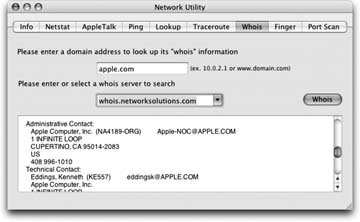
Figure 10-45. The Whois tool is a powerful part of Network Utility. First enter a domain that you want information about, then choose a Whois server from the pop-up menu (you might try whois. networksolutions.com). When you click the Whois button, you get a surprisingly revealing report about the owner of the domain, including phone numbers, fax numbers, contact names, and so on.
-
Traceroute lets you track how many "hops" are required for your Mac to communicate with a certain Web server. Just type in the network address or URL, and then click Trace. You'll see that your request actually jumps from one trunk of the Internet to another, from router to router, as it makes its way to its destination. You'll learn that a message sometimes crisscrosses the entire country before it arrives at its destination. You can also see how long each leg of the journey took, in milliseconds.
10.26.19. ODBC Administrator
This program is designed to arbitrate ODBC access requests . Any questions?
If you have no idea what that means, and no corporate system administrator has sat down to explain it to you, then your daily work probably doesn't involve working with corporate ODBC (Open Database Connectivity) databases. You can ignore this program or throw it away.
10.26.20. Printer Setup Utility
This is the hub of your Mac's printing operations. You can use the Printer Setup Utility (formerly called Print Center) to set up and configure new printers, and to check on the status of print jobs, as described in Chapter 14.
10.26.21. System Profiler
System Profiler (once called Apple System Profiler) is a great tool for learning exactly what's installed on your Mac and what's notin terms of both hardware and software. The people who answer the phones on Apple's tech-support line are particularly fond of System Profiler, since the detailed information it reports can be very useful for troubleshooting nasty problems.
Tip: Instead of burrowing into your Applications
 Utilities folder to open System Profiler, its sometimes faster to use this trick: Choose
Utilities folder to open System Profiler, its sometimes faster to use this trick: Choose  About This Mac. In the resulting dialog box, click the More Info button. BoomSystem Profiler opens. (And if you click your Mac OS X version number twice in the About box, you get to see your Macs serial number!)
About This Mac. In the resulting dialog box, click the More Info button. BoomSystem Profiler opens. (And if you click your Mac OS X version number twice in the About box, you get to see your Macs serial number!) When you launch System Profiler, it reports information about your Mac in a list down the left side (Figure 10-46).
|
They fall into these categories:
-
Hardware . Click this word to see precisely which model Mac you have, what kind of chip is inside (and how many), how much memory it has, and its serial number.
If you expand the flippy triangle, you get to see details about which Memory slots are filled and the size of the memory module in each slot; what kind of Disc Burning your Mac can do (DVD-R, DVD+R, and so on); what PCI Cards are installed in your expansion slots; what Graphics/Displays circuitry you have (graphics card and monitor); what's attached to your ATA bus (internal drives, like your DVD drive and hard drive); what's connected to your SCSI, USB , and FireWire chains, if anything; and much more.
-
Network . This section reveals details on your AirPort Card (if you have one), what Modems you have, what Internet connection Locations you've established (Section 19.5), and so on.
-
Software . Click this heading to see exactly which version of Mac OS X you have, and what your computer's name is, as far as the network is concerned ("Chris's Computer," for example).
The Applications list documents every program on your system, with version informationa quick inventory of what you've installed on your Mac. It's useful for spotting duplicate copies of programs.
| POWER USERS' CLINIC The Xcode Tools |
| The Tiger DVD includes a special batch of programs, known as the XCode Tools, just for developers (programmers) who write Mac OS X software. You'll need some of these programs if you want to get into some of the more esoteric (or, as some would say, fun) Mac OS X tricks and tips. To install these tools, open Xcode Tools CrashReporterPrefs , for example, lets you tell Mac OS X when to display the "Application Unexpectedly Quit" dialog box. If you choose Server, you'll never see one of those annoying dialog boxes againperfect if you have a program that just won't stop crashing. Also, if you open Developer Finally, don't miss Core Image Fun House (also in Developer When you're done psychedelicizing your image, you can export it to a standard JPEG or TIFF image by choosing File |
Similar information shows up in the Extensions panel. In this sense, "extensions" doesn't mean system extensions like those that made life a living hell in Mac OS 9 and earlier. In Mac OS X, the term extensions refers to a different kind of add-on component to the core system software. Generally, these are drivers for the Mac's various components, which sit in the System  Library
Library  Extensions folder. Whatevers in that folder is what you see listed in this panel.
Extensions folder. Whatevers in that folder is what you see listed in this panel.
Other categories include self-explanatory lists like Fonts, Preference Panes , and Startup Items .
Finally, the Logs panel reveals your Mac's secret diary: a record of the traumatic events that it experiences from day to day. (Many of these are the same as those revealed by the Console utility; see Section 10.26.7.) Some reveal crash logs , which are detailed technical descriptions of what went wrong when various programs crashed, and what was stored in memory at the time.
Unfortunately, there's not much plain English here to help you understand the crash, or how to avoid it in the future. Most of it runs along the lines of "Exception: EXC_BAD_ACCESS (0x0001); Codes: KERN_INVALID_ADDRESS (0x0001) at 0x2f6b657d." In other words, it's primarily for the benefit of programmers. Still, tech-support staff may occasionally ask to see the information in one of these logs.
Tip: If any of these screens is showing you more or less technical information than you'd like, use the View menu to choose Mini Profile, Basic Profile, or Full Profile.
10.26.21.1. Saving a report
To create a handsomely formatted report that you can print or save, choose File  Save, and then choose Rich Text Format from the File Format pop-up menu. Note, however, that the resulting report can be well over 100 pages long. In many cases, youre better off simply making a screen shot of the relevant Profiler screen, as described on Section 14.9.
Save, and then choose Rich Text Format from the File Format pop-up menu. Note, however, that the resulting report can be well over 100 pages long. In many cases, youre better off simply making a screen shot of the relevant Profiler screen, as described on Section 14.9.
10.26.22. Terminal
Terminal opens a terminal window with a command line interface , taking you deep into the world of Unix, the operating system on which Mac OS X is based. Chapters 16 and 17 offer a crash course on this powerful window into the Mac's shadow operating system.
10.26.23. VoiceOver Utility
For details on this new screen-reader software, see Section 15.5.1.1.
| < Day Day Up > |
EAN: 2147483647
Pages: 506
